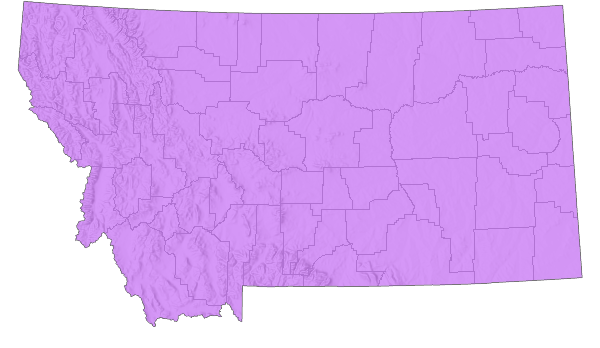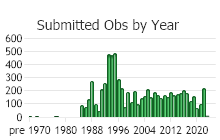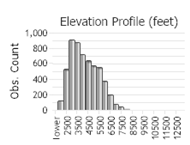View in other NatureServe Network Field Guides
NatureServe
Montana
Utah
Wyoming
Idaho
Wisconsin
British Columbia
South Carolina
Yukon
California
New York
Common Snowberry - Symphoricarpos albus
Native Species
Global Rank:
G5
State Rank:
S5
C-value:
4
Agency Status
USFWS:
USFS:
BLM:
External Links
General Description
Stems spreading to erect, highly branched, 50–150 cm; twigs brown, glabrous. Leaves ovate, 1–5 cm long, sparsely villous beneath. Inflorescence mostly with 6 flowers or less. Flowers: corolla campanulate, 4–7 mm long, lobes shorter than the tube; style glabrous, 2–3 mm long; style and stamens included. Berry 8–15 mm long (
Lesica et al. 2012. Manual of Montana Vascular Plants. BRIT Press. Fort Worth, TX).
Species Range
Montana Range
Range Descriptions

 Native
Native
Range Comments
Symphoricarpos albus occurs throughout North America, excluding Mexico. It may be associated with Festuca idahoensis or Cragaegus on north-facing slopes in the Palouse region of eastern Washington and northern Idaho (Daubenmire 1970, Allen et al. 1980). In the Blue Mountains of northeastern Oregon it is found with Festuca idahoensis, Agropyron spicatum, Poa sandbergii and Carex geyeri in grasslands and as an element of the understory in Ponderosa pine forests (Holechek et al. 1982). The species also occurs in Douglas fir zones of southern British Columbia (McLean 1969). Agee and Dunwiddie (1984) found S. albus in two habitats on Yellow Island in Puget Sound, Washington: (1) in woodlands associated with madrone, Oregon white oak, and invading Douglas fir and (2) as an element of the understory in Douglas fir- madrone-grand fir forests. According to Munz and Keck (1968), it is found on banks and flats in canyons and near streams below 4,000 feet in mixed evergreen forests, foothill woodlands, yellow pine forests, etc., of the Coast Ranges of California from Monterey County north and northern Sierra Nevada to Alaska.
Observations in Montana Natural Heritage Program Database
Number of Observations: 7235
(Click on the following maps and charts to see full sized version)
Map Help and Descriptions
Relative Density

Recency



 (Observations spanning multiple months or years are excluded from time charts)
(Observations spanning multiple months or years are excluded from time charts)
Habitat
Ecology
POLLINATORS The following animal species have been reported as pollinators of this plant species or its genus where their geographic ranges overlap:
Bombus vagans,
Bombus bifarius,
Bombus centralis,
Bombus flavifrons,
Bombus frigidus,
Bombus melanopygus,
Bombus mixtus,
Bombus occidentalis,
Bombus pensylvanicus,
Bombus griseocollis, and
Bombus impatiens (Thorp et al. 1983, Wilson et al. 2010, Colla and Dumesh 2010, Koch et al. 2012, Williams et al. 2014).
Stewardship Responsibility
References
- Literature Cited AboveLegend:
 View Online Publication
View Online Publication Colla, S.R. and S. Dumesh. 2010. The bumble bees of southern Ontario: notes on natural history and distribution. Journal of the Entomological Society of Ontario 141:39-68.
Colla, S.R. and S. Dumesh. 2010. The bumble bees of southern Ontario: notes on natural history and distribution. Journal of the Entomological Society of Ontario 141:39-68. Koch, J., J. Strange, and P. Williams. 2012. Bumble bees of the western United States. Washington, DC: USDA Forest Service, Pollinator Partnership. 143 p.
Koch, J., J. Strange, and P. Williams. 2012. Bumble bees of the western United States. Washington, DC: USDA Forest Service, Pollinator Partnership. 143 p. Lesica, P., M.T. Lavin, and P.F. Stickney. 2012. Manual of Montana Vascular Plants. Fort Worth, TX: BRIT Press. viii + 771 p.
Lesica, P., M.T. Lavin, and P.F. Stickney. 2012. Manual of Montana Vascular Plants. Fort Worth, TX: BRIT Press. viii + 771 p. Thorp, R.W., D.S. Horning, and L.L. Dunning. 1983. Bumble bees and cuckoo bumble bees of California (Hymenoptera: Apidae). Bulletin of the California Insect Survey 23:1-79.
Thorp, R.W., D.S. Horning, and L.L. Dunning. 1983. Bumble bees and cuckoo bumble bees of California (Hymenoptera: Apidae). Bulletin of the California Insect Survey 23:1-79. Williams, P., R. Thorp, L. Richardson, and S. Colla. 2014. Bumble Bees of North America. Princeton, NJ: Princeton University Press. 208 p.
Williams, P., R. Thorp, L. Richardson, and S. Colla. 2014. Bumble Bees of North America. Princeton, NJ: Princeton University Press. 208 p. Wilson, J.S., L.E. Wilson, L.D. Loftis, and T. Griswold. 2010. The montane bee fauna of north central Washington, USA, with floral associations. Western North American Naturalist 70(2): 198-207.
Wilson, J.S., L.E. Wilson, L.D. Loftis, and T. Griswold. 2010. The montane bee fauna of north central Washington, USA, with floral associations. Western North American Naturalist 70(2): 198-207.
- Additional ReferencesLegend:
 View Online Publication
View Online Publication
Do you know of a citation we're missing? Ament, R.J. 1995. Pioneer Plant Communities Five Years After the 1988 Yellowstone Fires. M.Sc. Thesis. Bozeman, MT: Montana State University. 216 p.
Ament, R.J. 1995. Pioneer Plant Communities Five Years After the 1988 Yellowstone Fires. M.Sc. Thesis. Bozeman, MT: Montana State University. 216 p. Aradottir, A.L. 1984. Ammonia volatilization from native grasslands and forests of SW Montana. M.Sc. Thesis. Bozeman, MT: Montana State University. 48 p.
Aradottir, A.L. 1984. Ammonia volatilization from native grasslands and forests of SW Montana. M.Sc. Thesis. Bozeman, MT: Montana State University. 48 p. Buckmaster, 2015. Community Composition Analysis of Altered Vegetation Communities Following the Release of Grazing Pressure. M.Sc. Thesis. Bozema, MT: Montana State University. 66 p.
Buckmaster, 2015. Community Composition Analysis of Altered Vegetation Communities Following the Release of Grazing Pressure. M.Sc. Thesis. Bozema, MT: Montana State University. 66 p. Clark, D. 1991. The effect of fire on Yellowstone ecosystem seed banks. M.Sc. Thesis. Montana State University, Bozeman. 115 pp.
Clark, D. 1991. The effect of fire on Yellowstone ecosystem seed banks. M.Sc. Thesis. Montana State University, Bozeman. 115 pp. Cramer, P.C. 1992. Small mammal diversity and abundance in Douglas Fir old growth forests. M.Sc. Thesis. Bozeman, MT: Montana State University. 64 p.
Cramer, P.C. 1992. Small mammal diversity and abundance in Douglas Fir old growth forests. M.Sc. Thesis. Bozeman, MT: Montana State University. 64 p. Dresser, M.A. 2015. Demographic responses of woodpeckers in relation to a Mountain Pine Beetle epidemic in the Elkhorn Mountains of Montana. M.Sc. Thesis. Bozeman, MT: Montana State University. 71 p.
Dresser, M.A. 2015. Demographic responses of woodpeckers in relation to a Mountain Pine Beetle epidemic in the Elkhorn Mountains of Montana. M.Sc. Thesis. Bozeman, MT: Montana State University. 71 p. DuBois, K.L. 1979. An inventory of the avifauna in the Long Pines of Southeastern Montana. M.Sc. Thesis. Bozeman, MT: Montana State University. 113 p.
DuBois, K.L. 1979. An inventory of the avifauna in the Long Pines of Southeastern Montana. M.Sc. Thesis. Bozeman, MT: Montana State University. 113 p. Enk, E.A. 1999. Population dynamics of bighorn sheep on the Beartooth Wildlife Management Area, Montana. Ph.D. Dissertation. Bozeman, MT: Montana State University. 177 p.
Enk, E.A. 1999. Population dynamics of bighorn sheep on the Beartooth Wildlife Management Area, Montana. Ph.D. Dissertation. Bozeman, MT: Montana State University. 177 p. Gaffney, W.S. 1941. The effects of winter elk browsing, South Fork of the Flathead River, Montana. Journal of Wildlife Management 5(4):427-453.
Gaffney, W.S. 1941. The effects of winter elk browsing, South Fork of the Flathead River, Montana. Journal of Wildlife Management 5(4):427-453. Glazier, R.J. 1971. Ecological and morphological relationships of subspecies of Peromyscus maniculatus near St. Mary, Montana. M.Sc. Thesis. Bozeman, Montana: Montana State University. 41 p.
Glazier, R.J. 1971. Ecological and morphological relationships of subspecies of Peromyscus maniculatus near St. Mary, Montana. M.Sc. Thesis. Bozeman, Montana: Montana State University. 41 p. Gobeille, J.E. 1992. The effect of fire on Merriams turkey brood habitat in southeastern Montana. M.Sc. Thesis. Bozeman, MT: Montana State University. 61 p.
Gobeille, J.E. 1992. The effect of fire on Merriams turkey brood habitat in southeastern Montana. M.Sc. Thesis. Bozeman, MT: Montana State University. 61 p. Guenther, G.E. 1989. Ecological relationships of bitterbrush communities on the Mount Haggin Wildlife Management Area. M.Sc. Thesis. Bozeman, MT: Montana State University. 73 p.
Guenther, G.E. 1989. Ecological relationships of bitterbrush communities on the Mount Haggin Wildlife Management Area. M.Sc. Thesis. Bozeman, MT: Montana State University. 73 p. Hale, K.M. 2007. Investigations of the West Nile virus transmission cycle at Medicine Lake National Wildlife Refuge, Montana, 2005-2006. M.Sc. Thesis. Bozeman, MT: Montana State University. 74 p.
Hale, K.M. 2007. Investigations of the West Nile virus transmission cycle at Medicine Lake National Wildlife Refuge, Montana, 2005-2006. M.Sc. Thesis. Bozeman, MT: Montana State University. 74 p. Hodgson, J.R. 1970. Ecological distribution of Microtus montanus and Microtus pennsylvanicus in an area of geographic sympatry in southwestern Montana. Ph.D. Dissertation. Bozeman, Montana: Montana State University. 65 p.
Hodgson, J.R. 1970. Ecological distribution of Microtus montanus and Microtus pennsylvanicus in an area of geographic sympatry in southwestern Montana. Ph.D. Dissertation. Bozeman, Montana: Montana State University. 65 p. Holeckek, J.L. 1976. Initial effects of different species treatments and fertilizer rates on a mine spoils rehabilitation. M.Sc. Thesis. Bozeman, MT: Montana State University. 91 p.
Holeckek, J.L. 1976. Initial effects of different species treatments and fertilizer rates on a mine spoils rehabilitation. M.Sc. Thesis. Bozeman, MT: Montana State University. 91 p. Jeanes, E.D. 1996. Behavioral responses to water current of age-0 Arctic Grayling from the Madison River, and their use of stream habitat. M.Sc. Thesis. Bozeman, MT: Montana State University. 60p.
Jeanes, E.D. 1996. Behavioral responses to water current of age-0 Arctic Grayling from the Madison River, and their use of stream habitat. M.Sc. Thesis. Bozeman, MT: Montana State University. 60p. Johnson, T. W. 1982. An analysis of pack and saddle stock grazing areas in the Bob Marshall Wilderness. M.Sc.Thesis. Bozeman, MT: Montana State University. 105 p.
Johnson, T. W. 1982. An analysis of pack and saddle stock grazing areas in the Bob Marshall Wilderness. M.Sc.Thesis. Bozeman, MT: Montana State University. 105 p. Klebenow, D.A. 1965. A montane forest winter deer habitat in western Montana. Journal of Wildlife Management 29(1):27-33.
Klebenow, D.A. 1965. A montane forest winter deer habitat in western Montana. Journal of Wildlife Management 29(1):27-33. Law, D.J. 1999. A comparison of water table dynamics and soil texture under black cottonwood recent alluvial bar, beaked sedge, and Geyer's/Drummond's willow communities. M.Sc. Thesis. Bozeman, MT: Montana State University. 68 p.
Law, D.J. 1999. A comparison of water table dynamics and soil texture under black cottonwood recent alluvial bar, beaked sedge, and Geyer's/Drummond's willow communities. M.Sc. Thesis. Bozeman, MT: Montana State University. 68 p. Lesica, P., M.T. Lavin, and P.F. Stickney. 2022. Manual of Montana Vascular Plants, Second Edition. Fort Worth, TX: BRIT Press. viii + 779 p.
Lesica, P., M.T. Lavin, and P.F. Stickney. 2022. Manual of Montana Vascular Plants, Second Edition. Fort Worth, TX: BRIT Press. viii + 779 p. Martin, P.R. 1973. Ecology of skunkbrush sumac (Rhus trilobata Nutt.) in Montana with special reference to use by mule deer. M.Sc. Thesis. Bozeman, MT: Montana State University. 97 p.
Martin, P.R. 1973. Ecology of skunkbrush sumac (Rhus trilobata Nutt.) in Montana with special reference to use by mule deer. M.Sc. Thesis. Bozeman, MT: Montana State University. 97 p. Martinka, R.R. 1970. Structural characteristics and ecological relationships of male blue grouse (Dendragapus obscurus (Say)) territories in southwestern Montana. Ph.D Dissertation. Bozeman, MT: Montana State University. 73 p.
Martinka, R.R. 1970. Structural characteristics and ecological relationships of male blue grouse (Dendragapus obscurus (Say)) territories in southwestern Montana. Ph.D Dissertation. Bozeman, MT: Montana State University. 73 p. McClure, W.V. 1991. Initial effects of streambank stabilization on a small trout stream. M.Sc. Thesis. Bozeman, MT: Montana State University. 93 p.
McClure, W.V. 1991. Initial effects of streambank stabilization on a small trout stream. M.Sc. Thesis. Bozeman, MT: Montana State University. 93 p. McColley, S.D. 2007. Restoring aspen riparian stands with beaver on the northern Yellowstone winter range. M.Sc. Thesis. Bozeman, MT: Montana State University. 67 p.
McColley, S.D. 2007. Restoring aspen riparian stands with beaver on the northern Yellowstone winter range. M.Sc. Thesis. Bozeman, MT: Montana State University. 67 p. Meier, G.A. 1997. The colonization of Montana roadsides by native and exotic plants. M.Sc. Thesis. Bozeman, MT: Montana State University. 45 p.
Meier, G.A. 1997. The colonization of Montana roadsides by native and exotic plants. M.Sc. Thesis. Bozeman, MT: Montana State University. 45 p. Miller, J.G. 1978. An ecoligical study of creeping juniper (Juniperus horizontalis Moench.) in Montana. M.Sc. Thesis. Bozeman, MT: Montana State University. 154 p.
Miller, J.G. 1978. An ecoligical study of creeping juniper (Juniperus horizontalis Moench.) in Montana. M.Sc. Thesis. Bozeman, MT: Montana State University. 154 p. Morgan, J.T. 1993. Summer habitat use of white-tailed deer on the Tally Lake ranger district, Flathead National Forest. Ph.D. Dissertation. Montana State University, Bozeman. pp. 103.
Morgan, J.T. 1993. Summer habitat use of white-tailed deer on the Tally Lake ranger district, Flathead National Forest. Ph.D. Dissertation. Montana State University, Bozeman. pp. 103. Morton, M.A. 1976. Nutritional values of major mule deer winter forage species in the Bridger Mountains, Montana. M.Sc. Thesis. Bozeman, MT: Montana State University. 105 p.
Morton, M.A. 1976. Nutritional values of major mule deer winter forage species in the Bridger Mountains, Montana. M.Sc. Thesis. Bozeman, MT: Montana State University. 105 p. Mosher, B.A. 2011. Avian community response to a mountain beetle epidemic. M.Sc. Thesis. Bozeman, MT: Montana State University. 55 p.
Mosher, B.A. 2011. Avian community response to a mountain beetle epidemic. M.Sc. Thesis. Bozeman, MT: Montana State University. 55 p. Pac, D.F. 1976. Distribution, movements, and habitat use during spring, summer, and fall by mule deer associated with Armstrong winter range, Bridger Mountains, Montana. M.Sc. Thesis. Bozeman, MT: Montana State University. 121 p.
Pac, D.F. 1976. Distribution, movements, and habitat use during spring, summer, and fall by mule deer associated with Armstrong winter range, Bridger Mountains, Montana. M.Sc. Thesis. Bozeman, MT: Montana State University. 121 p. Plaggemeyer, J.B. 1995. Effects of overstory thinning on lodgepole pine understories. M.Sc. Thesis. Bozeman, MT: Montana State University. 55 p.
Plaggemeyer, J.B. 1995. Effects of overstory thinning on lodgepole pine understories. M.Sc. Thesis. Bozeman, MT: Montana State University. 55 p. Quire, R.L. 2013. The sagebrush steppe of Montana and southeastern Idaho shows evidence of high native plant diversity, stability, and resistance to the detrimental effects of nonnative plant species. M.Sc. Thesis. Bozeman, MT: Montana State University. 124 p.
Quire, R.L. 2013. The sagebrush steppe of Montana and southeastern Idaho shows evidence of high native plant diversity, stability, and resistance to the detrimental effects of nonnative plant species. M.Sc. Thesis. Bozeman, MT: Montana State University. 124 p. Reichel, J.D., D.L. Genter and E. Atkinson. 1992. Sensitive animal species in the Elkhorn and Big Belt Mountains of the Helena National Forest. Unpublished report to the Helena National Forest. Montana Natural Heritage Program, Helena. 158 p.
Reichel, J.D., D.L. Genter and E. Atkinson. 1992. Sensitive animal species in the Elkhorn and Big Belt Mountains of the Helena National Forest. Unpublished report to the Helena National Forest. Montana Natural Heritage Program, Helena. 158 p. Rosgaard, A.I., Jr. 1981. Ecology of the mule deer associated with the Brackett Creek winter range in the Bridger Mountains, Montana. M.Sc. Thesis. Bozeman, MT: Montana State University. 76 p.
Rosgaard, A.I., Jr. 1981. Ecology of the mule deer associated with the Brackett Creek winter range in the Bridger Mountains, Montana. M.Sc. Thesis. Bozeman, MT: Montana State University. 76 p. Schubloom, L.A. 1995. Lichens as air quality indicators in three areas of southwestern Montana: lichen floristics and elemental analysis. M.Sc. Thesis. Bozeman, MT: Montana State University. 130 p.
Schubloom, L.A. 1995. Lichens as air quality indicators in three areas of southwestern Montana: lichen floristics and elemental analysis. M.Sc. Thesis. Bozeman, MT: Montana State University. 130 p. Seipel, T.F. 2006. Plant species diversity in the sagebrush steppe of Montana. M.Sc. Thesis. Bozeman, MT: Montana State University. 87 p.
Seipel, T.F. 2006. Plant species diversity in the sagebrush steppe of Montana. M.Sc. Thesis. Bozeman, MT: Montana State University. 87 p. Selting, J.P. 1994. Seasonal use of agricultural lands by Mule Deer, White-Tailed Deer, and Pronghorn Antelope in Carter County, Montana. M.Sc. Thesis. Bozeman, Montana: Montana State University. 66 p.
Selting, J.P. 1994. Seasonal use of agricultural lands by Mule Deer, White-Tailed Deer, and Pronghorn Antelope in Carter County, Montana. M.Sc. Thesis. Bozeman, Montana: Montana State University. 66 p. Semmens, W.J. 1996. Seasonal movements and habitat use of the Highlands/Pioneer Mountains bighorn sheep herd of southwest Montana. M. Sc. Thesis. Bozeman, MT: Montana State University. 103 p.
Semmens, W.J. 1996. Seasonal movements and habitat use of the Highlands/Pioneer Mountains bighorn sheep herd of southwest Montana. M. Sc. Thesis. Bozeman, MT: Montana State University. 103 p. Sikes, D.S. 1994. Influences of ungulate carcasses on Coleopteran communities in Yellowstone National Park, USA. M.Sc. Thesis. Bozeman, MT: Montana State University. 179 p.
Sikes, D.S. 1994. Influences of ungulate carcasses on Coleopteran communities in Yellowstone National Park, USA. M.Sc. Thesis. Bozeman, MT: Montana State University. 179 p. Simanonok, M. 2018. Plant-pollinator network assembly after wildfire. Ph.D. Dissertation. Bozeman, MT: Montana State University. 123 p.
Simanonok, M. 2018. Plant-pollinator network assembly after wildfire. Ph.D. Dissertation. Bozeman, MT: Montana State University. 123 p. Simanonok, M.P. and L.A. Burkle. 2019. Nesting success of wood-cavity-nesting bees declines with increasing time since wildfire. Ecology and Evolution 9:12436-12445.
Simanonok, M.P. and L.A. Burkle. 2019. Nesting success of wood-cavity-nesting bees declines with increasing time since wildfire. Ecology and Evolution 9:12436-12445. Singer, F. J. 1979. Habitat partitioning and wildfire relationships of cervids in Glacier National Park, Montana. Journal of Wildlife Management 43(2):437-444.
Singer, F. J. 1979. Habitat partitioning and wildfire relationships of cervids in Glacier National Park, Montana. Journal of Wildlife Management 43(2):437-444. South, P.R. 1957. Food habits and range use of the mule deer in the Scudder Creek area, Beaverhead County, Montana. M.Sc. Thesis. Bozeman, MT: Montana State University. 34 p.
South, P.R. 1957. Food habits and range use of the mule deer in the Scudder Creek area, Beaverhead County, Montana. M.Sc. Thesis. Bozeman, MT: Montana State University. 34 p. Stansberry, B.J. 1991. Distribution, movements, and habitat use during spring, summer, and fall by mule deer in the North Salish Mountains, Montana. M.Sc. Thesis. Bozeman, MT: Montana State University. 64 p.
Stansberry, B.J. 1991. Distribution, movements, and habitat use during spring, summer, and fall by mule deer in the North Salish Mountains, Montana. M.Sc. Thesis. Bozeman, MT: Montana State University. 64 p. Steerey, W. F. 1979. Distribution, range use and population characteristics of Mule Deer associated with the Schafer Creek winter range, Bridger Mountains, Montana. M.Sc. Thesis. Bozeman, Montana: Montana State University. 119 p.
Steerey, W. F. 1979. Distribution, range use and population characteristics of Mule Deer associated with the Schafer Creek winter range, Bridger Mountains, Montana. M.Sc. Thesis. Bozeman, Montana: Montana State University. 119 p. Stevens, D.R. 1970. Winter ecology of moose in the Gallatin Mountains, Montana. Journal of Wildlife Management 34(1):37-46.
Stevens, D.R. 1970. Winter ecology of moose in the Gallatin Mountains, Montana. Journal of Wildlife Management 34(1):37-46. Stewart, S.T. 1975. Ecology of the West Rosebud and Stillwater bighorn sheep herds, Beartooth Mountains, Montana. M.Sc. Thesis. Bozeman, MT: Montana State University. 130 p.
Stewart, S.T. 1975. Ecology of the West Rosebud and Stillwater bighorn sheep herds, Beartooth Mountains, Montana. M.Sc. Thesis. Bozeman, MT: Montana State University. 130 p. Stivers, T.S. 1988. Effects of livestock grazing on grizzly bear habitat along the east front of the Rocky Mountains, Montana. M.Sc. Thesis. Bozeman, MT: Montana State University. 80 p.
Stivers, T.S. 1988. Effects of livestock grazing on grizzly bear habitat along the east front of the Rocky Mountains, Montana. M.Sc. Thesis. Bozeman, MT: Montana State University. 80 p. Sundeen, D.R. 1968. Abundance and movement of young trout in a portion of the Madison River, Montana. M.Sc. Thesis. Bozeman, Montana: Montana State University. 19 p.
Sundeen, D.R. 1968. Abundance and movement of young trout in a portion of the Madison River, Montana. M.Sc. Thesis. Bozeman, Montana: Montana State University. 19 p. Thompson, Scott K. 2002. Browse condition and trend on Montana ungulate ranges. M.Sc. Thesis. Bozeman, MT: Montana State University. 147 p.
Thompson, Scott K. 2002. Browse condition and trend on Montana ungulate ranges. M.Sc. Thesis. Bozeman, MT: Montana State University. 147 p. Thompson, W. L. 1993. Ecology of Merriam's Turkeys in relation to burned and logged areas in southeastern Montana. Ph.D. Dissertation. Bozeman, MT: Montana State University. 195 p.
Thompson, W. L. 1993. Ecology of Merriam's Turkeys in relation to burned and logged areas in southeastern Montana. Ph.D. Dissertation. Bozeman, MT: Montana State University. 195 p. Trout, R.G. 1978. Small mammal abundance and distribution in the Missouri River Breaks, Montana. M.Sc. Thesis. Bozeman, Montana: Montana State University. 64 p.
Trout, R.G. 1978. Small mammal abundance and distribution in the Missouri River Breaks, Montana. M.Sc. Thesis. Bozeman, Montana: Montana State University. 64 p. Tuinstra, K. E. 1967. Vegetation of the floodplains and first terraces of Rock Creek near Red Lodge, Montana. Ph.D dissertation. Montana State University, Bozeman 110 pp.
Tuinstra, K. E. 1967. Vegetation of the floodplains and first terraces of Rock Creek near Red Lodge, Montana. Ph.D dissertation. Montana State University, Bozeman 110 pp. Tyers, D.B. 2003. Winter ecology of moose on the Northern Yellowstone Winter Range. Ph.D. Dissertation. Bozeman, MT: Montana State University. 308 p.
Tyers, D.B. 2003. Winter ecology of moose on the Northern Yellowstone Winter Range. Ph.D. Dissertation. Bozeman, MT: Montana State University. 308 p. Williams, K.L. 2012. Classification of the grasslands, shrublands, woodlands, forests and alpine vegetation associations of the Custer National Forest portion of the Beartooth Mountains in southcentral Montana. M.Sc. Thesis. Bozeman, MT: Montana State University. 376 p.
Williams, K.L. 2012. Classification of the grasslands, shrublands, woodlands, forests and alpine vegetation associations of the Custer National Forest portion of the Beartooth Mountains in southcentral Montana. M.Sc. Thesis. Bozeman, MT: Montana State University. 376 p. Zimmer, J.P. 2004. Winter habitat use and diet of Snowshoe Hares in the Gardiner, Montana area. M.Sc. Thesis. Bozeman, MT: Montana State University. 65 p.
Zimmer, J.P. 2004. Winter habitat use and diet of Snowshoe Hares in the Gardiner, Montana area. M.Sc. Thesis. Bozeman, MT: Montana State University. 65 p.
- Web Search Engines for Articles on "Common Snowberry"





